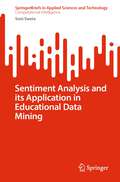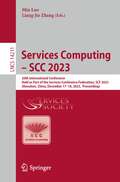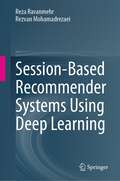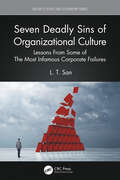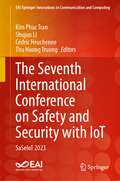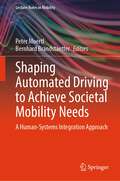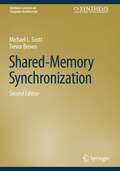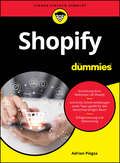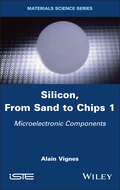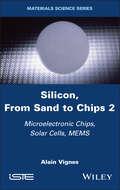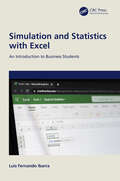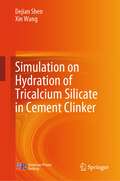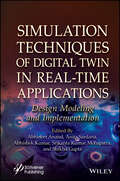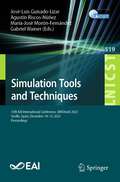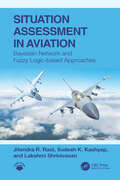- Table View
- List View
The Sensory Accommodation Framework for Technology: Bridging Sensory Processing to Social Cognition (Synthesis Lectures on Technology and Health)
by LouAnne BoydThis book provides a thorough introduction to the many facets of designing technologies for autism, with a particular focus on optimizing visual attention frameworks. This book is designed to provide a detailed overview of several aspects of technology for autism. Each Chapter illustrates different parts of the Sensory Accommodation Framework and provides examples of relevant available technologies. The books first discusses a variety of skills that make up human development as well as a history of autism as a diagnosis and the birth of the neurodiversity movement. It goes on to detail individual types of therapy and how they interact with autism. The systems involved in sensory processing and their specific relation to autism are then explored, including through technologies that have addressed these areas and applications for designers. Readers will learn about designing sensory environments and sensory interactions, such as through virtual reality. This book places a needed emphasis on the hierarchy of information in technology development by exploring visual attention in neurodivergent conditions like autism, ADHD, and dyslexia. It also delves into the relationship between sensory perception and nonverbal communication, the bridge between sensory input and social behavior, and dynamic information. The discussion is rounded out with examinations of temporal processing as and multisensory integration as complicating factors that have existing technological solutions. Finally, the book closes with a summary of the sensory accommodation framework in respect to how each layer offers different user experience goals and specific mechanisms to promote those goals. Readers from a variety of research backgrounds will find this book informative and useful, while designers will learn essential skills for effectively designing autism technologies.
Sentiment Analysis and its Application in Educational Data Mining (SpringerBriefs in Applied Sciences and Technology)
by Soni SwetaThe book delves into the fundamental concepts of sentiment analysis, its techniques, and its practical applications in the context of educational data. The book begins by introducing the concept of sentiment analysis and its relevance in educational settings. It provides a thorough overview of the various techniques used for sentiment analysis, including natural language processing, machine learning, and deep learning algorithms. The subsequent chapters explore applications of sentiment analysis in educational data mining across multiple domains. The book illustrates how sentiment analysis can be employed to analyze student feedback and sentiment patterns, enabling educators to gain valuable insights into student engagement, motivation, and satisfaction. It also examines how sentiment analysis can be used to identify and address students' emotional states, such as stress, boredom, or confusion, leading to more personalized and effective interventions. Furthermore, the book explores the integration of sentiment analysis with other educational data mining techniques, such as clustering, classification, and predictive modeling. It showcases real-world case studies and examples that demonstrate how sentiment analysis can be combined with these approaches to improve educational decision-making, curriculum design, and adaptive learning systems.
Service-Oriented Computing – ICSOC 2023 Workshops: AI-PA, ASOCA, SAPD, SQS, SSCOPE, WESOACS and Satellite Events, Rome, Italy, November 28-December 1, 2023, Revised Selected Papers (Lecture Notes in Computer Science #14518)
by Flavia Monti Pierluigi Plebani Naouel Moha Hye-Young Paik Johanna Barzen Gowri Ramachandran Devis Bianchini Damian A. Tamburri Massimo MecellaThis book constitutes revised selected papers from the scientific satellite events held in conjunction with the 21st International Conference on Service-Oriented Computing, ICSOC 2023. The conference was held in Rome, Italy, during November 28 – December 1, 2023.This year, these satellite events were organized around four main tracks, including a workshop track, a demonstration track, a Ph.D. symposium, and an invited tutorial track.The ICSOC 2023 workshop track consisted of the following six workshops covering a wide range of topics that fall into the general area of service computing:Third International Workshop on AI-Enabled Process Automation (AI-PA 2023)7th Workshop on Adaptive Service-Oriented and Cloud Applications (ASOCA2023)First International Workshop on Secure, Accountable and Privacy-Preserving Data-Driven Service-Oriented Computing (SAPD 2023)First Services and Quantum Software Workshop (SQS 2023)First International Workshop on Sustainable Service-Oriented Computing: Addressing Environmental, Social, and Economic Dimensions (SSCOPE 2023) 19th International Workshop on Engineering Service-Oriented Applications and Cloud Services (WESOACS 2023)
Services Computing – SCC 2023: 20th International Conference, Held as Part of the Services Conference Federation, SCF 2023, Shenzhen, China, December 17–18, 2023, Proceedings (Lecture Notes in Computer Science #14211)
by Min Luo Liang-Jie ZhangThis book constitutes the refereed proceedings of the 20th International Conference on Services Computing, SCC 2023, held in Shenzhen, China, during December 17–18, 2023.The 6 full papers in this book were carefully reviewed and selected from 18 submissions. They are organized in topical sections as follows: business modeling, business consulting, solution creation, service delivery, and software architecture design, development, and deployment.
Session-Based Recommender Systems Using Deep Learning
by Reza Ravanmehr Rezvan MohamadrezaeiThis book focuses on the widespread use of deep neural networks and their various techniques in session-based recommender systems (SBRS). It presents the success of using deep learning techniques in many SBRS applications from different perspectives. For this purpose, the concepts and fundamentals of SBRS are fully elaborated, and different deep learning techniques focusing on the development of SBRS are studied. The book is well-modularized, and each chapter can be read in a stand-alone manner based on individual interests and needs. In the first chapter of the book, definitions and concepts related to SBRS are reviewed, and a taxonomy of different SBRS approaches is presented, where the characteristics and applications of each class are discussed separately. The second chapter starts with the basic concepts of deep learning and the characteristics of each model. Then, each deep learning model, along with its architecture and mathematical foundations, is introduced. Next, chapter 3 analyses different approaches of deep discriminative models in session-based recommender systems. In the fourth chapter, session-based recommender systems that benefit from deep generative neural networks are discussed. Subsequently, chapter 5 discusses session-based recommender systems using advanced/hybrid deep learning models. Eventually, chapter 6 reviews different learning-to-rank methods focusing on information retrieval and recommender system domains. Finally, the results of the investigations and findings from the research review conducted throughout the book are presented in a conclusive summary. This book aims at researchers who intend to use deep learning models to solve the challenges related to SBRS. The target audience includes researchers entering the field, graduate students specializing in recommender systems, web data mining, information retrieval, or machine/deep learning, and advanced industry developers working on recommender systems.
Seven Deadly Sins of Organizational Culture: Lessons From Some of The Most Infamous Corporate Failures (Security, Audit and Leadership Series)
by L. T. SanThis book is about the primary symptoms present in a dysfunctional culture that could have devastating outcomes for any organization. The book outlines each of the seven sins in each chapter. Each of the first seven chapters (Chapters 1–7) starts with a famous quote related to each of the sins and then immediately recounts stories ripped from the headlines describing well-known corporate failures but with a personal touch from former employees who experienced those stories from inside the company. (The sources for these stories are all cited in their Bibliographies.) The seven sins of organizational culture are linked with seven different corporate scandals that serve as a "lesson learned" as well as seven stories of organizations that have been successful with each respective organizational attribute as follows: Flawed Mission and Misaligned Values uses WorldCom as the lesson learned and Patagonia as the success case. Flawed Incentives uses Wells Fargo as the lesson learned and Bridgeport Financial as the success case. Lack of Accountability uses HSBC as the lesson learned and McDonald’s as the success case. Ineffective Talent Management uses Enron as the lesson learned and Southwest Airlines as the success case. Lack of Transparency uses Theranos as the lesson learned and Zappos as the success case. Ineffective Risk Management uses the 2008 mortgage industry collapse as the lesson learned and Michael Burry as the success case. Ineffective Leadership summarizes all of the foregoing sins as failures of Leadership. In each chapter and for each organizational sin, the author offers seven attributes of a healthy culture to counter the cultural dysfunction. The seven healthy attributes for each of the seven sins are all original content. In Chapter 8, the author offers an approach for assessing an organization’s culture by providing seven ways to measure the different drivers of organizational culture. The ideas for how to measure corporate culture is original content, with some references to existing frameworks (all cited in the Bibliography.) Finally, in Chapter 9, the author offers a step-by-step outline for transforming the culture. The chapter starts with a story about how Korean Air suffered multiple crashes due to their corporate culture but were able to successfully transform their culture. (The source for the Korean Air story is cited in the Bibliography.) There are seven appendices, most of which are by the author except for the maturity of risk management, which references an OECD (government entity) risk management maturity framework.
Seven Deadly Sins of Organizational Culture: Lessons From Some of The Most Infamous Corporate Failures (Security, Audit and Leadership Series)
by L. T. SanThis book is about the primary symptoms present in a dysfunctional culture that could have devastating outcomes for any organization. The book outlines each of the seven sins in each chapter. Each of the first seven chapters (Chapters 1–7) starts with a famous quote related to each of the sins and then immediately recounts stories ripped from the headlines describing well-known corporate failures but with a personal touch from former employees who experienced those stories from inside the company. (The sources for these stories are all cited in their Bibliographies.) The seven sins of organizational culture are linked with seven different corporate scandals that serve as a "lesson learned" as well as seven stories of organizations that have been successful with each respective organizational attribute as follows: Flawed Mission and Misaligned Values uses WorldCom as the lesson learned and Patagonia as the success case. Flawed Incentives uses Wells Fargo as the lesson learned and Bridgeport Financial as the success case. Lack of Accountability uses HSBC as the lesson learned and McDonald’s as the success case. Ineffective Talent Management uses Enron as the lesson learned and Southwest Airlines as the success case. Lack of Transparency uses Theranos as the lesson learned and Zappos as the success case. Ineffective Risk Management uses the 2008 mortgage industry collapse as the lesson learned and Michael Burry as the success case. Ineffective Leadership summarizes all of the foregoing sins as failures of Leadership. In each chapter and for each organizational sin, the author offers seven attributes of a healthy culture to counter the cultural dysfunction. The seven healthy attributes for each of the seven sins are all original content. In Chapter 8, the author offers an approach for assessing an organization’s culture by providing seven ways to measure the different drivers of organizational culture. The ideas for how to measure corporate culture is original content, with some references to existing frameworks (all cited in the Bibliography.) Finally, in Chapter 9, the author offers a step-by-step outline for transforming the culture. The chapter starts with a story about how Korean Air suffered multiple crashes due to their corporate culture but were able to successfully transform their culture. (The source for the Korean Air story is cited in the Bibliography.) There are seven appendices, most of which are by the author except for the maturity of risk management, which references an OECD (government entity) risk management maturity framework.
The Seventh International Conference on Safety and Security with IoT: SaSeIoT 2023 (EAI/Springer Innovations in Communication and Computing)
by Kim Phuc Tran Shujun Li Cédric Heuchenne Thu Huong TruongThis book presents the Fifth International Conference on Safety and Security with IoT (SaSeIoT 2023), which took place Bratislava, Slovakia, October 24-26, 2023. The conference aims to explore not only IoT and its related critical applications but also IoT towards Security and Safety. The conference solicits original and inspiring research contributions from experts, researchers, designers, and practitioners in academia, industry and related fields and provides a common platform to share knowledge, experience and best practices in various domains of IoT.
Shaping Automated Driving to Achieve Societal Mobility Needs: A Human-Systems Integration Approach (Lecture Notes in Mobility)
by Peter Moertl Bernhard BrandstaetterThis edited book describes novel human-systems integration approaches to improve acceptance, safety, and comfort of automated vehicles. Each chapter analyses different aspects in the development of automated driving systems such as: assessing needs and opportunities of specific user populations i.e. elderly drivers and truck drivers; creating fluid human-systems interactions in the vehicle to answer specific driver needs; developing an automated driving tutoring application; and identifying benefits of including road infrastructure sensors to support automated driving predictability. A detailed description of the assessment of the above-described solutions in real-world situations is also included. Written by both researchers and professionals, this book offers timely and practice-oriented information concerning the development of automated driving systems that better adapt to the users’ needs.
Shared-Memory Synchronization (Synthesis Lectures on Computer Architecture)
by Michael L. Scott Trevor BrownThis book offers a comprehensive survey of shared-memory synchronization, with an emphasis on “systems-level” issues. It includes sufficient coverage of architectural details to understand correctness and performance on modern multicore machines, and sufficient coverage of higher-level issues to understand how synchronization is embedded in modern programming languages.The primary intended audience for this book is “systems programmers”—the authors of operating systems, library packages, language run-time systems, concurrent data structures, and server and utility programs. Much of the discussion should also be of interest to application programmers who want to make good use of the synchronization mechanisms available to them, and to computer architects who want to understand the ramifications of their design decisions on systems-level code.
Shifting Mobility: Part 1: Transforming Planning and Design for New Human Mobility Code
by Dewan Masud KarimIn the face of resource depletion, environmental changes, lifestyle changes, demographic and digital adaptation, old ideologies of city building and expensive and complex automobility solutions are in freefall. These changes are creating severe friction between the old and new paradigms. This book provides new perspectives through the process of ideological disassociation and concepts of human mobility code. The basic premise of the book, human mobility is an essential component of our creativity that comes from our unconscious desire to become a part of a community. Several new concepts in the book starts with the hallmark of new discovery of human mobility code and its implications of urban mobility boundary systems to stay within safe planetary zone. A new discovery of human mobility code from comprehensive research finding prove that each individual develops a unique mobility footprint and become our mobility identity. Beyond individual hallmarks, human develops collective mobility codes through interaction with the third space on which entire mobility systems lie and are created by the fundamentals of city planning and the design process. Readers are introduced to an innovative mobility planning process and reinvention of multimodal mobility approaches based on new mobility code while formulating new concepts, practical solutions and implementation techniques, tools, policies, and processes to reinforce low-carbon mobility options while addressing social equity, environmental, and health benefits. Finally, the book arms us with knowledge to prevent the disaster of full technological enlightenment against our natural human mobility code.
Shifting Mobility: Part 1: Transforming Planning and Design for New Human Mobility Code
by Dewan Masud KarimIn the face of resource depletion, environmental changes, lifestyle changes, demographic and digital adaptation, old ideologies of city building and expensive and complex automobility solutions are in freefall. These changes are creating severe friction between the old and new paradigms. This book provides new perspectives through the process of ideological disassociation and concepts of human mobility code. The basic premise of the book, human mobility is an essential component of our creativity that comes from our unconscious desire to become a part of a community. Several new concepts in the book starts with the hallmark of new discovery of human mobility code and its implications of urban mobility boundary systems to stay within safe planetary zone. A new discovery of human mobility code from comprehensive research finding prove that each individual develops a unique mobility footprint and become our mobility identity. Beyond individual hallmarks, human develops collective mobility codes through interaction with the third space on which entire mobility systems lie and are created by the fundamentals of city planning and the design process. Readers are introduced to an innovative mobility planning process and reinvention of multimodal mobility approaches based on new mobility code while formulating new concepts, practical solutions and implementation techniques, tools, policies, and processes to reinforce low-carbon mobility options while addressing social equity, environmental, and health benefits. Finally, the book arms us with knowledge to prevent the disaster of full technological enlightenment against our natural human mobility code.
Shopify für Dummies (Für Dummies)
by Adrian PiegsaIn kürzester Zeit erfolgreich auf Shopify Mit Shopify bauen Sie Ihren eigenen Online-Shop, der perfekt zu Ihren Bedürfnissen passt. Adrian Piegsa gibt Ihnen einen Überblick über die Shop-Plattform, zeigt Ihnen, wie Sie sich zurechtfinden und worauf Sie achten müssen. Sie lernen Schritt für Schritt, wie Sie Ihren Webshop mit Kategorien und Produkten anlegen, Bestellungen abwickeln und Ihren Erfolg optimieren. Darüber hinaus erfahren Sie alles über Vertriebs- und Werbemöglichkeiten von Shopify und erhalten Tipps und Tricks im Umgang mit der Software ? speziell für den deutschsprachigen Raum. Sie erfahren Wie Sie sich auf Shopify zurechtfinden Was eine gute Shop-Struktur ausmacht Wie Sie Shopify-Apps sinnvoll nutzen Wie Sie Ihre Statistiken einsehen und auswerten
Silicon, From Sand to Chips, Volume 1: Microelectronic Components
by Alain VignesSilicon is the material of the digital revolution, of solar energy and of digital photography, which has revolutionized both astronomy and medical imaging. It is also the material of microelectromechanical systems (MEMS), indispensable components of smart objects. The discovery of the electronic and optoelectronic properties of germanium and silicon during the Second World War, followed by the invention of the transistor, ushered in the digital age. Although the first transistors were made from germanium, silicon eventually became the preferred material for these technologies. Silicon, From Sand to Chips 1 traces the history of the discoveries, inventions and developments in basic components and chips that these two materials enabled one after the other. The book is divided into two volumes and this first volume is devoted to basic microelectronic components.
Silicon, From Sand to Chips, Volume 1: Microelectronic Components
by Alain VignesSilicon is the material of the digital revolution, of solar energy and of digital photography, which has revolutionized both astronomy and medical imaging. It is also the material of microelectromechanical systems (MEMS), indispensable components of smart objects. The discovery of the electronic and optoelectronic properties of germanium and silicon during the Second World War, followed by the invention of the transistor, ushered in the digital age. Although the first transistors were made from germanium, silicon eventually became the preferred material for these technologies. Silicon, From Sand to Chips 1 traces the history of the discoveries, inventions and developments in basic components and chips that these two materials enabled one after the other. The book is divided into two volumes and this first volume is devoted to basic microelectronic components.
Silicon, From Sand to Chips, Volume 2: Microelectronic Chips, Solar Cells, MEMS
by Alain VignesSilicon is the material of the digital revolution, of solar energy and of digital photography, which has revolutionized both astronomy and medical imaging. It is also the material of microelectromechanical systems (MEMS), indispensable components of smart objects. The discovery of the electronic and optoelectronic properties of germanium and silicon during the Second World War, followed by the invention of the transistor, ushered in the digital age. Although the first transistors were made from germanium, silicon eventually became the preferred material for these technologies. Silicon, From Sand to Chips 2 traces the history of the discoveries, inventions and developments in basic components and chips that these two materials enabled one after the other. The book is divided into two volumes and this second volume is devoted to microelectronic and optoelectronic chips, solar cells and MEMS.
Silicon, From Sand to Chips, Volume 2: Microelectronic Chips, Solar Cells, MEMS
by Alain VignesSilicon is the material of the digital revolution, of solar energy and of digital photography, which has revolutionized both astronomy and medical imaging. It is also the material of microelectromechanical systems (MEMS), indispensable components of smart objects. The discovery of the electronic and optoelectronic properties of germanium and silicon during the Second World War, followed by the invention of the transistor, ushered in the digital age. Although the first transistors were made from germanium, silicon eventually became the preferred material for these technologies. Silicon, From Sand to Chips 2 traces the history of the discoveries, inventions and developments in basic components and chips that these two materials enabled one after the other. The book is divided into two volumes and this second volume is devoted to microelectronic and optoelectronic chips, solar cells and MEMS.
The Silicon Valley Model: Management for Entrepreneurship (Management for Professionals)
by Annika Steiber Sverker AlängeThe first edition of The Silicon Valley Model, published in 2016, addresses the need for a fundamentally new approach to managing and developing large firms with an emphasis on entrepreneurship. This second edition validates, extends, and updates these original findings. While still encompassing the observations and analysis featured in the first edition, this new edition addresses new developments in management and in the global business environment. Further, it presents Dr. Steiber’s research identifying more companies in Asia, Europe, and the USA that are implementing management approaches that parallels the Silicon Valley Model, and in some respects, advanced upon it. New material, appearing mainly in the “Recent Developments” sections in each chapter, includes both real-life events and new research findings related to the management principles for entrepreneurship. In some cases, elements of innovation and development of the Silicon Valley Model have taken new forms in response to changing times or the desires of the companies involved. The Silicon Valley Model, Second Edition is beneficial to executives from the board and CEO level on down, consultants, researchers, and others who study or work with new developments in management.
Simulation and Statistics with Excel: An Introduction to Business Students
by Luis Fernando IbarraThe use of simulation techniques has increased in importance in recent history, and simulation activities are an important resource for advanced preparation for the organization and execution of events. When formal mathematics is not enough, simulation may be the only option capable of approximating solutions. Simulation and Statistics with Excel: An Introduction to Business Students offers a non-rigorous and practical tour of the simulation procedure on computers, using a versatile and accessible resource, the Microsoft Excel spreadsheet. This book covers the concepts essential to understanding the basic principles and approaches of statistical simulation, allowing for the study of complex systems. Aimed at students in business and operational research beginning to use simulation as an instrument for understanding existing or proposed processes, this book will lay solid foundations in understanding simulation experimentation.Key Features: Provides a basis to understand the approaches and principles of simulator experiments. Uses a universal and easily accessible resource. Introduces simple examples to teach the fundamentals of simulation.
Simulation and Statistics with Excel: An Introduction to Business Students
by Luis Fernando IbarraThe use of simulation techniques has increased in importance in recent history, and simulation activities are an important resource for advanced preparation for the organization and execution of events. When formal mathematics is not enough, simulation may be the only option capable of approximating solutions. Simulation and Statistics with Excel: An Introduction to Business Students offers a non-rigorous and practical tour of the simulation procedure on computers, using a versatile and accessible resource, the Microsoft Excel spreadsheet. This book covers the concepts essential to understanding the basic principles and approaches of statistical simulation, allowing for the study of complex systems. Aimed at students in business and operational research beginning to use simulation as an instrument for understanding existing or proposed processes, this book will lay solid foundations in understanding simulation experimentation.Key Features: Provides a basis to understand the approaches and principles of simulator experiments. Uses a universal and easily accessible resource. Introduces simple examples to teach the fundamentals of simulation.
Simulation on Hydration of Tricalcium Silicate in Cement Clinker
by Dejian Shen Xin WangThis book is written based on authors' research on cement hydration during the past decade. It establishes simulation model to evaluate the influence of crystal defects on the dissolution of tricalcium silicate and morphology change of particles and explores the hydration kinetics and microstructure development of tricalcium silicate under the mixed control of dissolution, diffusion, as well as boundary nucleation and growth. It also provides a theoretical basis for regulating the microstructure and performance of cement-based materials. It is designed as a reference work for professionals or practitioners and as a textbook for undergraduates or postgraduates. This book provides valuable knowledge and useful methods that can be applied in the field of cement hydration.
Simulation Techniques of Digital Twin in Real-Time Applications: Design Modeling and Implementation
by Abhineet Anand Anita Sardana Abhishek Kumar Srikanta Kumar Mohapatra Shikha GuptaSIMULATION TECHNIQUES OF DIGITAL TWIN IN REAL-TIME APPLICATIONS The book gives a complete overview of implementing digital twin technology in real-time scenarios while emphasizing how this technology can be embedded with running technologies to solve all other issues. Divided into two parts with Part 1 focusing on simulated techniques in digital twin technology and Part 2 on real-time applications of digital twin technology, the book collects a significant number of important research articles from domain-specific experts. The book sheds light on the various techniques of digital twin technology that are implemented in various application areas. It emphasizes error findings and respective solutions before the actual event happens. Most of the features in the book are on the implementation of strategies in real-time applications. Various real-life experiences are taken to show the proper implementation of simulation technologies. The book shows how engineers of any technology can input their research ideas to convert to real scenarios by using replicas. Hence, the book has a collection of research articles from various engineers with expertise in different technologies from many regions of the world. It shows how to implement the embedded real-time data into technologies. Specifically, the chapters relate to the auto landing and cruising features in aerial vehicles, automated coal mining simulation strategy, the enhancement of workshop equipment, and implementation in power energy management for urban railways. This book also describes the coherent mechanism of digital twin technologies with deep neural networks and artificial intelligence. Audience Researchers, engineers, and students in computer science, software engineering and industrial engineering, will find this book to be very useful.
Simulation Techniques of Digital Twin in Real-Time Applications: Design Modeling and Implementation
by Abhishek Kumar Shikha Gupta Abhineet Anand Anita Sardana Srikanta Kumar MohapatraSIMULATION TECHNIQUES OF DIGITAL TWIN IN REAL-TIME APPLICATIONS The book gives a complete overview of implementing digital twin technology in real-time scenarios while emphasizing how this technology can be embedded with running technologies to solve all other issues. Divided into two parts with Part 1 focusing on simulated techniques in digital twin technology and Part 2 on real-time applications of digital twin technology, the book collects a significant number of important research articles from domain-specific experts. The book sheds light on the various techniques of digital twin technology that are implemented in various application areas. It emphasizes error findings and respective solutions before the actual event happens. Most of the features in the book are on the implementation of strategies in real-time applications. Various real-life experiences are taken to show the proper implementation of simulation technologies. The book shows how engineers of any technology can input their research ideas to convert to real scenarios by using replicas. Hence, the book has a collection of research articles from various engineers with expertise in different technologies from many regions of the world. It shows how to implement the embedded real-time data into technologies. Specifically, the chapters relate to the auto landing and cruising features in aerial vehicles, automated coal mining simulation strategy, the enhancement of workshop equipment, and implementation in power energy management for urban railways. This book also describes the coherent mechanism of digital twin technologies with deep neural networks and artificial intelligence. Audience Researchers, engineers, and students in computer science, software engineering and industrial engineering, will find this book to be very useful.
Simulation Tools and Techniques: 15th EAI International Conference, SIMUtools 2023, Seville, Spain, December 14-15, 2023, Proceedings (Lecture Notes of the Institute for Computer Sciences, Social Informatics and Telecommunications Engineering #519)
by Agustín Riscos-Núñez José-Luis Guisado-Lizar María-José Morón-Fernández Gabriel WainerThis proceedings constitutes the refereed post-conference proceedings of the 15th International Conference on Simulation Tools and Techniques, SIMUTools 2023, held in Seville, Spain, in December 2023. The 23 revised full papers were carefully selected from 58 submissions. The papers focus on various areas such as Simulation Tools and Methods; Artificial Intelligence and Simulation; Transportation and Logistics; Medical Sciences; and Network Simulations.
Situation Assessment in Aviation: Bayesian Network and Fuzzy Logic-based Approaches
by Jitendra R. Raol Sudesh K. Kashyap Lakshmi ShrinivasanSituation Assessment in Aviation focuses on new aspects of soft computing technologies for the evaluation and assessment of situations in aviation scenarios. It considers technologies emerging from multisensory data fusion (MSDF), Bayesian networks (BN), and fuzzy logic (FL) to assist pilots in their decision-making.Studying MSDF, BN, and FL from the perspective of their applications to the problem of situation assessment, the book discusses the development of certain soft technologies that can be further used for devising more sophisticated technologies for a pilot's decision-making when performing certain tasks: airplane monitoring, pair formation, attack, and threat. It explains the concepts of situation awareness, data fusion, decision fusion, Bayesian networks, fuzzy logic type 1, and interval type 2 fuzzy logic. The book also presents a hybrid technique by using BN and FL and a unique approach to the problem of situation assessment, beyond visual range and air-to-air combat, by utilizing building blocks of artificial intelligence (AI) for the future development of more advanced automated systems, especially using commercial software.The book is intended for aerospace R&D engineers, systems engineers, aeronautical engineers, and aviation training professionals. It will also be useful for aerospace and electrical engineering students taking courses in Air Traffic Management, Aviation Management, Aviation Operations, and Aviation Safety Systems.

